Even the name of this fly Calliphora vomitoria sounds kind of disgusting, with the ‘vomitoria’ no doubt relating to its habit of regurgitating its food and then eating it again. But it is not really its fault, as we will see later. ‘Bluebottle’ sounds better, which is a description of its gleaming blue abdomen. It belongs to a family of blowflies called Calliphoridae, which are fairly familiar to most of us as they are fairly large and stoutly built with a loud buzz. Most breed on decaying animal matter, and thereby assist nature in its essential recycling regime.
There are 14 genera and 38 species within Calliphoridae according to The Royal Entomological Society of British Insects (2011 edition), some of which include some of the greenbottle flies. There are 1500 worldwide. Calliphora vomitoria is often confused with Calliphora vicini. They both look superficially very similar, except with closer scrutiny Calliphora vomitoria has pale ‘cheeks’ and the jowls, below and behind the eyes, are covered in yellow/orange hairs. These can be seen on some of the images in this blog if you look carefully, but particularly in the image below and the final image. Double click on them for a closer look. Calliphora vomitoria grows up to 10–14 millimetres (0.4–0.6 in) long
It is said that blowfly maggots can compete with a lion at the speed in which they can strip a carcass down to the bone. This is obviously a fallacy, but it does reflect on the extraordinary efficiency with which these insects consume body tissues. At the smell of purification the adults will come, often in packs, and the females lay their eggs on soft tissue or near open orifices. The resulting maggots will feed quicker in hotter weather, but finally they will pupate within the corpse to emerge as adult flies. Despite how much we may loathe them, especially when they enter our houses and buzz around our heads and our food, they are our friends in that they help to clean up after death has had its way. Yes, they can spread disease and make food inedible, and the adult flies also vomit up their food to slurp it back up again. But evolution has not made their digestion as straight forward as ours. Their stomachs simply cannot cope, so they have to take it a bit at a time, regurgitate, and then add a mix of digestive enzymes to help break it down and fit for their digestion.
Calliphora vomitoria can be seen all year round, but mostly from March to October. They are common and widespread in Britain, and can be found virtually anywhere.
As much as flies trouble us at our picnics buzzing around our heads and our food, as much as we revile them, they are intrinsically woven into the fabric of our lives, as they have been for many thousands of years. In forensic science they help establish a time of death. Some blowfly larvae from Lucilia sp. are used in maggot therapy to help cleanse wounds, removing necrotic tissue. The adults are very good pollinators. So here we have it in a buzz or two, despite some of their most horrible and terrible traits, there is a balance of where they do, do some good.
Let us finish on an interesting poem from Raymon Queneau, which just shows how flies and humans play a dance throughout life until death:
When one sees flies, one thinks: they came from maggots. When one sees men, one thinks, to maggots they will come.
Photographs taken in August 2017, rear garden, Staffordshire, England.
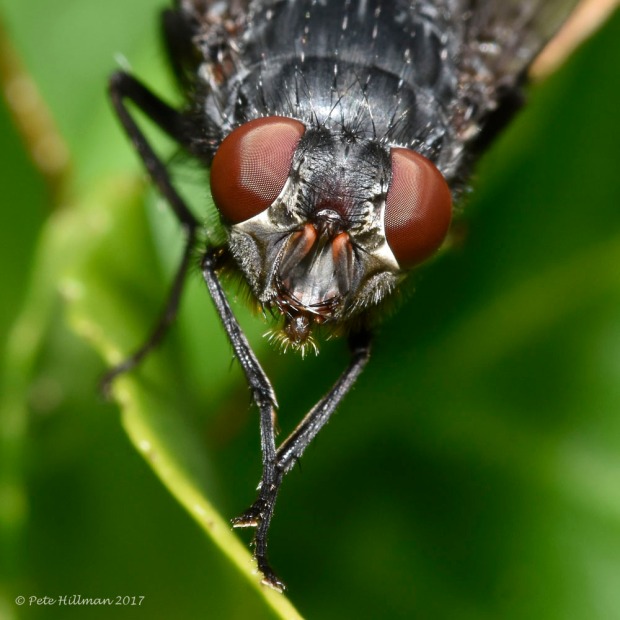
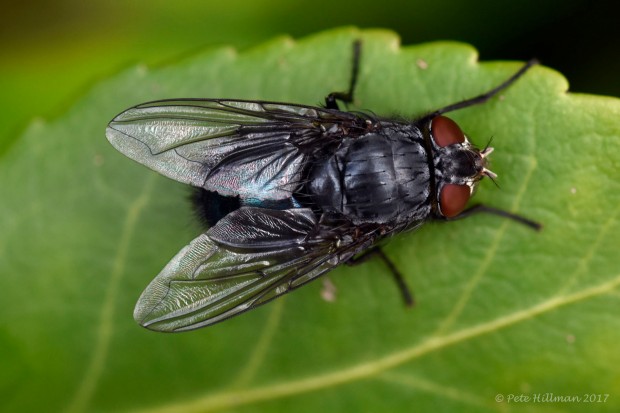
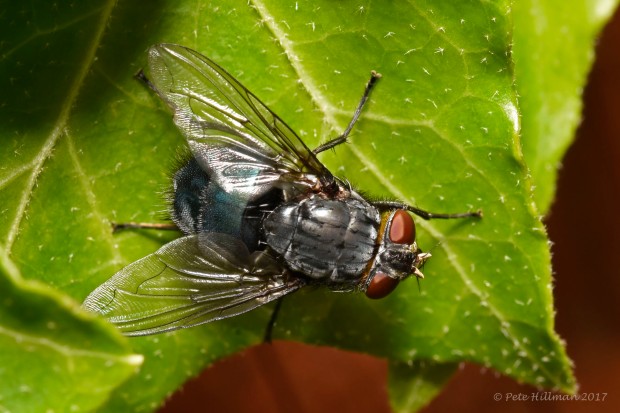
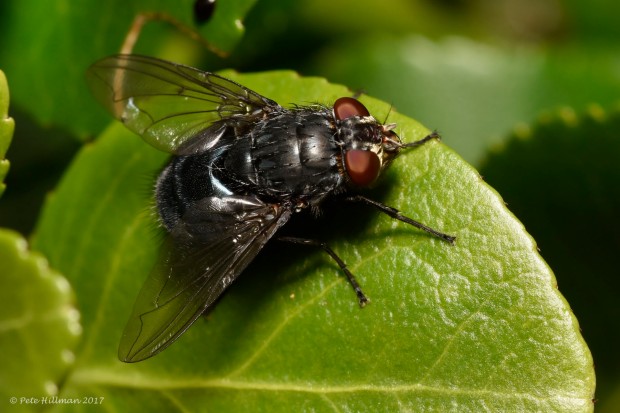
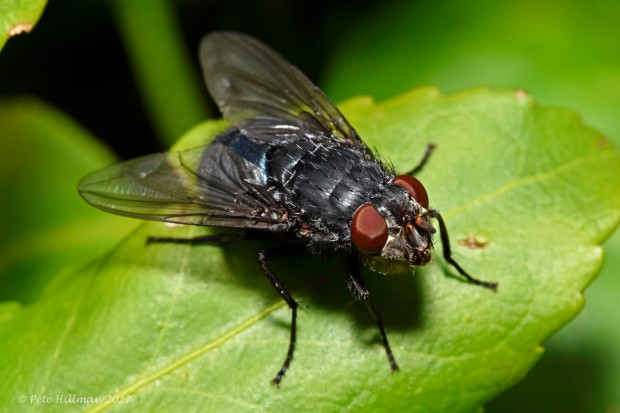
Amazing close ups.
LikeLiked by 1 person
Thank you, Rabirius 🙂
LikeLike
Gerat pictures! I’ve never seen the eyes of a fly in such detail.
LikeLiked by 1 person
Thank you 🙂
LikeLike
I agree…the name does sound disgusting! Great photos though!
LikeLiked by 1 person
Thank you 🙂
LikeLike
Fabulous photos! I presume your new equipment helped out. As sort-of-disgusting as these flies are, they are a marker for every sort of event taking place around us. A few years ago, there was a “something” that died in the walls of the house, and the odor was terrible. Then, the flies showed up. An exterminator said, “Let them be. You’ll find that the flies will disappear at about the same time the odor does, and you won’t need my services to clean up the mess.”
And so it was. The smell went away, and so did the flies — on the hunt for their next meal, no doubt.
LikeLiked by 2 people
Thank you, Linda 🙂 That is a very good point and a way to save money.
LikeLike
It’s nice to see that they do some benefits. They gross me out, of course.
LikeLiked by 1 person
Thank you 🙂 And me to a degree.
LikeLiked by 1 person
It’s beautiful and scary at the same time
LikeLiked by 1 person
Thank you 🙂
LikeLiked by 1 person
I’m disgusted and fascinated at the same time. Great pics Pete!
LikeLiked by 1 person
Thank you, Diana 🙂 I used to have a phobia when I was younger over maggots, still do to a degree, after playing in a neighbours oil drum full of rotting birdseed. I was only a young boy at the time, and for many, many years I could not even look at pictures of the white wiggly things, for they used to turn my stomach. But my interest in the natural world has helped me as time has moved on 🙂
LikeLiked by 1 person
Oh this is a terrifying tale indeed! Discovering them in an unsuspecting way is horrifying – I came across some in my organic scraps recycling recently. I was amazed at how fast they moved. Strangely enough I couldn’t bring myself to kill them though. Transferred them to the apartment building’s larger receptacle instead. A few days later I was not surprised that there was a sudden fly infestation 😮
LikeLiked by 1 person
🙂
LikeLike
I remember reading many years ago, that if you have an injury in the middle of nowhere, nothing cleans infection out better than blow fly maggots. While the thought is disgusting and downright creepy, I guess it has its merits.
LikeLiked by 1 person
It creeps me out, too!
LikeLiked by 1 person
You’re information is always so interesting. I can’t say that I actually “Like” the flies, but I can say I “Like” the info!
LikeLiked by 1 person
Thank you, James 🙂
LikeLike
Interesting facts. Why do they get called ‘blowflies?’
LikeLiked by 1 person
Interesting question. I believe is goes back many years and is related to the misassumption that the females blew the eggs onto rotting carcasses like a boy blowing peas from a peashooter. Then we have the term ‘flyblown’ meat also.
LikeLiked by 1 person
I love that first bug-eyed closeup! And very interesting stuff you’ve written.
LikeLiked by 1 person
Thank you, Michael 🙂
LikeLike
Wow! However annoying these little blighters are, it is fascinating to see such awesome close-ups, with such interesting information.
LikeLiked by 1 person
Thank you very much, Jill 🙂 They maybe repulsive and they are certainy troublesome, yet fascinating they are, too.
LikeLike